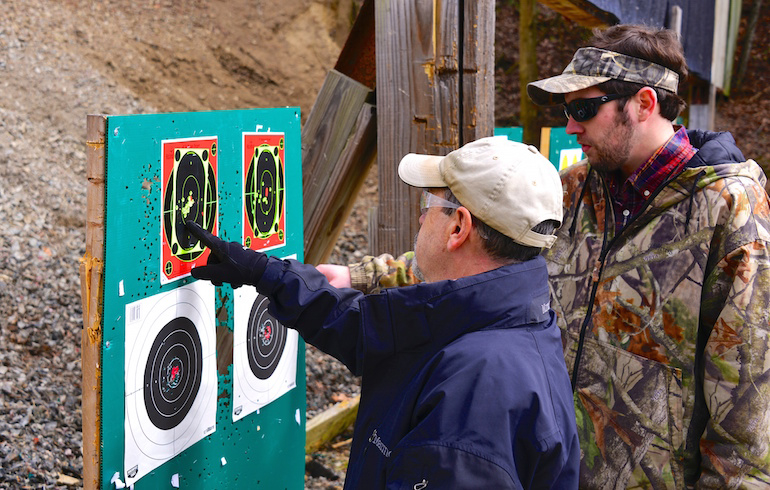How To Best Get Sighted In For Deer Season
Ok, a lot of us have been guilty of this at some time in the past and many hunters still are.
Opening day is drawing close, we’ve been busy with work and other activities, and with weeks, maybe even days before the deer season blows wide open, we have yet to take our rifle or slug gun out and even fire a single shot. Remember, when sighting in your rifle prior to the season, it’s technically not just about “if” your gun is on; it’s really more about if you as a shooter are on.

And to that end, setting at a bench, punching a few holes in a paper plate and declaring that you’re ready for the season is hardly adequate. That is unless you’re guaranteed a shot with a broadside standing deer at relatively close range (and maybe wearing a paper plate taped to its side.) For the sake of our confidence as shooters and hunters, the sake of ensuring the unspoken commitment to the game that we hunt to make the cleanest, killingest shots possible and to put as close to a lock as possible on our season’s success, let’s take those extra steps this preseason. Now is a good time, while there is still plenty of days to practice before the opener.
To ensure your sight-in sessions are as productive as possible, keep the following in mind:
Take a Rest – Before getting too gung-ho and making sure you are as prepped with mad skills as a marksman can be, you do need to make sure you gun is on target. And just because it was the last time you shot it last year, doesn’t mean it still is. The scope could’ve been knocked, the gun could have an issue, maybe you changed ammo or plan to change the loads you were using last year and the new ones hit a slightly different point-of-aim. There’s plenty that can and will go wrong. So start on a shooting bench—not holding against a tree or kneeling along a fence railing—and use a good rest—sand bags or a solidly constructed rifle or shotgun rest—and shoot a couple of groups. Make any necessary adjustments to your scope or sights and ensure groups are as tight as your gun/load combo is possible.
Shoot Cold—Note where your point-of-impact puts the bullet when the barrel is fired while cold. Then shoot several five-shot groups and see if the point-of-impact changes as the barrel heats up. If you discover the point-of-impact changing, allow your barrel to cool considerably between shots before making adjustments. Remember, when you take that all important first, and hopefully, only shot at that buck of a lifetime this deer season, you will be shooting from a likely very cold barrel. To reduce cool off time between shots, keep the gun in the shade, shoot from the shade, rest the gun pointed up between shots to allow heat to rise out of the muzzle and if electricity is available, Field & Stream’s David Petzal even recommends running a fan and allowing it to blow across the barrel of the gun.
Shoot Near and Far—If sighting the gun in for the first time, bore sight it and then start shooting at a target 25 yards away. This makes it easier to get it on paper and dial it in quickly. With most gun/optic combinations, you should be able to have it about dialed in within a handful of shots. Once you’re hitting your bulls-eye, move the target out to 100 yards. You should still be pretty close to center at this distance. Dial the crosshairs or red dot in even more until you’re sending tight inch to 2-inch groups down-range. While most deer will be taken at less than 100 yards, in many areas, shots, even with a slug gun, can be expected to be farther out. If you hunt somewhere and plan to shoot your slug gun out to 150 and even 200 yards, or your rifle out to 300 or more yards, then be sure you practice, and practice a lot, at the range before ever attempting those shots at game. Wind, game movement, unseen brush or obstructions and even topography and temperature can affect bullet placement at such distances, and if we haven’t practiced the shots and perfected them at the range, we shouldn’t try them in the field.
Stick with the Same Load—Whether sighting in a rifle at the range or going into the field, use the same load, bullet and bullet weight every time after you’ve found one that works well from your firearm. Even though there are a lot of suitable loads for whitetails available in many calibers, every bullet and bullet weight can hit differently—and a few inches off at 100 yards can turn into more than a foot off at 300 yards.
Choose a Good Load—And practice with it. It doesn’t make much sense when a hunter will spend hundreds and even thousands on a new gun and optic and then try to save a few bucks by using cheap ammunition. Many of us are extremely price conscious and there is nothing wrong with being frugal. Just be sure you select a reliable load such as Winchester’s Ballistic Silvertip or their new Deer Season XP. If you’re shopping for a new load and not sure which one to try, check out the “Choose Your Ammo” tab at Winchester.com for every deer-suitable load in the company’s line-up. You can then compare ballistic stats and specs to get an idea of which one might perform best in your type of firearm.




